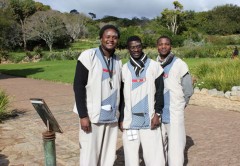Cape Malay Cuisine of South Africa
Cape Malay cuisine is, as its name implies, a fusion of a traditional South African essence (specifically from the Cape on the West Coast, now known as Cape Town) and Malaysian, or Eastern influences. Its flavours are well-known to locals, and remain a major part of the South African culture. Due to its unique quality, Cape Malay cooking has become an important part of the South African identity, as well as of the tourist experience.
Did you know? The aromatic nature of Cape Malay dishes is due to the cinnamon, saffron, tamarind, and fruit that they like to add, not forgetting plenty of chillies.
When the Dutch colonised the Cape in the 1600's and 1700's, they brought with them people from the East to work as slaves for them. These exiles originally landed at the area now known as Green Point in Cape Town, leaving the massive ship to begin a life of the unknown on the Dark Continent.
To follow was a life of cruelty at the hands of the settlers, hardships, and then the battle of the Apartheid regime. While undeniably tragic, this led to the Cape Malay people's establishing extremely close bonds with one another and clinging to their unique culture and belief system. The Bo-Kaap is still known as the heart of the Cape Malay people and their fascinating culture. District Six was another important hub for these folk.
In general, the Cape Malay exiles adhered to Islam, while the European settlers were Christian. This not only meant very different beliefs and customs, but also a completely different set of cooking techniques. In most cases, the modern Cape Malays adhere to their traditional Islam roots.
The Cape Malay cuisine is characterised by aromatic, strong flavours with complex lists of ingredients. There are some Asian elements that are easier to identify in traditional Cape Malay dishes, but there are also plenty of African and European nuances too.
Popular Cape Malay dishes include plenty of fish (having lived off the produce of the sea on their doorstep since their arrival), as well as stews, roasts and spicy curries. The aromatic nature of their dishes is due to the cinnamon, saffron, tamarind, and fruit that they like to add, not forgetting plenty of chillies.
They are also famous for their homemade chutneys and atchar. Many of their seafood dishes are salted (such as snoek served with apricot jam), curried or pickled. This hails back to the days in which they did not have refrigerators, being forced to preserve the dishes in some other way.
Breads are also important in the Cape Malay cuisine. Rotis are flatbreads that are used to hold and mop up saucy curries, for example. Curries are served with sambals that help to make the fiery burn less painful for children or those that prefer slightly milder foods. These include sweet chutneys, tomato and onion, and plain yoghurt.
Although the Cape Malay culture is such an important one in the Western Cape and South Africa, it actually does not feature much outside of this province. Cookbooks that are dedicated to this cuisine style are available countrywide, though, and promise a fantastic sample of the local fare for those that feel adventurous in the kitchen and who love spicy dishes.
Wish you were here?

Additional Reading
- Flavours Of South Africa – Recipes For All The South African Favourites
- 10 Uniquely South African foods
- Best food & drink ‘hoods in Cape Town
- 15 Reasons to Visit Cape Town At LEAST Once in Your Life
- Visit these 5 Popular Kramats in Cape Town – The Circle Of Kramats
- 10 Quintessential South African Ingredients every Chef has
Also See

Lakes / Dams / Landmarks / Miscellaneous
Dams on Table Mountain
There are five dams on top of the table top, accessible via a number of hikes up the mountain. The dams - The Woodhead, Hely-Hutchinson, De Villiers, Alexandria and Victoria - are all on the mountain's back ...

Landmarks
Table Mountain
Since the first person laid eyes on Table Mountain, it has exerted its powerful and charismatic pull, enchanting and drawing any and all who fall under its spell. The way to the top has never been easy, and for many centuries only a handful of bold and ...

National Parks
Table Mountain National Park
At the south-western tip of South Africa, the Table Mountain National Park encompasses the incredibly scenic Peninsula mountain chain stretching from Signal Hill in the north to Cape Point in the south, a distance of approximately 60 km. The narrow ...
Restaurants in South Africa
Where to sample traditional cuisine
Tips & Information for Tourists
- Travelling to South Africa? We make it easy for you to plan your trip online. We have some useful tips for tourists and then start planning your trip with our introduction to South Africa.
- By Province
- Getting to South Africa
- Getting Around in South Africa
- South Africa's Climate
- Exchange Rates and Currency
- Maps / Atlas
- Malaria Risk Areas
- Wildlife
- Birdlife
- Plant Life
- Languages and Culture
- South African Cuisine
- Top Attractions in South Africa
- Popular Tourist Routes
- Find a Hotel
SA-Venues.com® has been assisting travellers with their South Africa travel plans since 1999, and is the largest, independent online travel guide for South Africa available in both English and German.
SA-Venues.com © 1999-2025. All Rights Reserved. Find and book hotels and accommodation in South Africa. Sitemap














